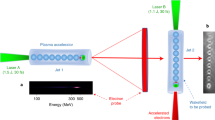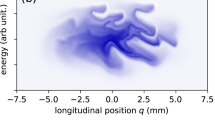Abstract
EXPERIMENTS are in progress on the mechanism of the breakdown of gases at centimetre wavelengths, some of which have already been reported1. In the previous communication reference was made to the mid-gap streamers which, at atmospheric pressure, seem to constitute the birth-stage of a spark in a resonator energized at 2,800 megacycles per second. These streamers are regularly produced when a narrow beam of short-wave ultra-violet light, from a spark gap, is passed through the gas between the electrodes immediately before the 1·4-micro-second pulse reaches the resonator (Fig. 1). Photoelectrons in the gas itself execute oscillations of small amplitude in the electric field, and cause breakdown if the field is strong enough.
This is a preview of subscription content, access via your institution
Access options
Subscribe to this journal
Receive 51 print issues and online access
$199.00 per year
only $3.90 per issue
Buy this article
- Purchase on Springer Link
- Instant access to full article PDF
Prices may be subject to local taxes which are calculated during checkout
Similar content being viewed by others
References
Prowse and Cooper, Nature, 161, 310 (1948).
Rogowski and Klemperer, Arch. Elek., 24, 127 (1930). Buss, Arch. Elek., 26, 266 (1932).
Cooper, J. Inst. Elect. Eng., 94, Pt. 3, 315 (1947).
Rosenlocher, Arch. Elek., 26, 115 (1932).
Author information
Authors and Affiliations
Rights and permissions
About this article
Cite this article
PROWSE, W., JASIŃSKI, W. Oscillographic Observations on Ultra-High-Frequency Sparks. Nature 163, 103–104 (1949). https://doi.org/10.1038/163103b0
Published:
Issue Date:
DOI: https://doi.org/10.1038/163103b0
Comments
By submitting a comment you agree to abide by our Terms and Community Guidelines. If you find something abusive or that does not comply with our terms or guidelines please flag it as inappropriate.



